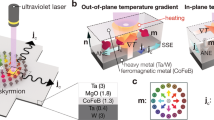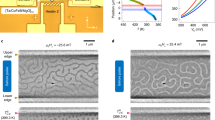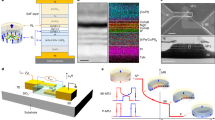Abstract
Magnetic skyrmions are localized non-collinear spin textures with a high potential for future spintronic applications1,2,3,4,5,6,7,8,9,10,11,12. Skyrmion phases have been discovered in a number of materials9,11 and a focus of current research is to prepare, detect and manipulate individual skyrmions for implementation in devices6,7,8. The local experimental characterization of skyrmions has been performed by, for example, Lorentz microscopy3 or atomic-scale tunnel magnetoresistance measurements using spin-polarized scanning tunnelling microscopy4,7,12. Here we report a drastic change of the differential tunnel conductance for magnetic skyrmions that arises from their non-collinearity: mixing between the spin channels locally alters the electronic structure, which makes a skyrmion electronically distinct from its ferromagnetic environment. We propose this tunnelling non-collinear magnetoresistance as a reliable all-electrical detection scheme for skyrmions with an easy implementation into device architectures.
This is a preview of subscription content, access via your institution
Access options
Subscribe to this journal
Receive 12 print issues and online access
$259.00 per year
only $21.58 per issue
Buy this article
- Purchase on Springer Link
- Instant access to full article PDF
Prices may be subject to local taxes which are calculated during checkout





Similar content being viewed by others
References
Bogdanov, A. N. & Yablonskii, D. A. Thermodynamically stable ‘vortices’ in magnetically ordered crystals. The mixed state of magnets. Sov. Phys. JETP 68, 101–103 (1989).
Mühlbauer, S. et al. Skyrmion lattice in a chiral magnet. Science 323, 915–919 (2009).
Yu, X. Z. et al. Real space observation of a two-dimensional skyrmion crystal. Nature 465, 901–904 (2010).
Heinze, S. et al. Spontaneous atomic-scale magnetic skyrmion lattice in two dimensions. Nature Phys. 7, 713–718 (2011).
Kiselev, N. S., Bogdanov, A. N., Schäfer, R. & Rößler, U. K. Chiral skyrmions in thin magnetic films: new objects for magnetic storage technology? J. Phys. D 44, 392001 (2011).
Fert, A., Cros, V., & Sampaio, J. Skyrmions on the track. Nature Nanotech. 8, 152–156 (2013).
Romming, N. et al. Writing and deleting single skyrmions. Science 341, 636–639 (2013).
Sampaio, J., Cros, V., Rohart, S., Thiaville, A. & Fert, A. Nucleation, stability and current-induced motion of isolated magnetic skyrmions in nanostructures. Nature Nanotech. 8, 839–844 (2013).
Nagaosa, N. & Tokura, Y. Topological properties and dynamics of magnetic skyrmions. Nature Nanotech. 8, 899–911 (2013).
Dupé, B., Hoffmann, M., Paillard, C. & Heinze, S. Tailoring magnetic skyrmions in ultra-thin transition metal films. Nature Commun. 5, 4030 (2014).
von Bergmann, K., Kubetzka, A., Pietzsch, O. & Wiesendanger, R. Interface-induced chiral domain walls, spin spirals and skyrmions revealed by spin-polarized scanning tunneling microscopy. J. Phys. Condens. Matter 26, 394002 (2014).
Romming, N., Kubetzka, A., Hanneken, C., von Bergmann, K. & Wiesendanger, R. Field-dependent size and shape of single magnetic skyrmions. Phys. Rev. Lett. 114, 177203 (2015).
Dzyaloshinskii, I. E. Thermodynamic theory of ‘weak’ ferromagnetism in antiferromagnetic substances. Sov. Phys. JETP 5, 1259–1262 (1957).
Moriya, T. Anisotropic superexchange interaction and weak ferromagnetism. Phys. Rev. 120, 91–98 (1960).
Fert, A. & Levy, P. A. Role of anisotropic exchange interactions in determining the properties of spin glasses. Phys. Rev. Lett. 44, 1538–1541 (1980).
Baibich, M. N. et al. Giant magnetoresistance of (001)Fe/(001)Cr magnetic superlattices. Phys. Rev. Lett. 61, 2472–2475 (1988).
Binasch, G., Grünberg, P., Saurenbach, F. & Zinn, W. Enhanced magneto-resistance in layered magnetic structures with antiferromagnetic interlayer exchange. Phys. Rev. B 39, 4828 (1989).
Jullière, M. Tunneling between ferromagnetic films. Phys. Lett. A 54, 225–226 (1975).
Wiesendanger, R., Güntherodt, H.-J., Güntherodt, G., Gambino, R. J. & Ruf, R. Observation of vacuum tunneling of spin-polarized electrons with the scanning tunneling microscope. Phys. Rev. Lett. 65, 247 (1990).
McGuire, T. R. & Potter, R. I. Anisotropic magnetoresistance in ferromagnetic 3D alloys. IEEE Trans. Magn. 11, 1018–1038 (1975).
Bode, M. et al. Magnetization-direction dependent local electronic structure probed by scanning tunneling spectroscopy. Phys. Rev. Lett. 89, 237205 (2002).
Gould, C. et al. Tunneling anisotropic magnetoresistance: a spin-valve-like tunnel magnetoresistance using a single magnetic layer. Phys. Rev. Lett. 93, 117203 (2004).
Levy, P. M. & Zhang, S. Resistivity due to domain wall scattering. Phys. Rev. Lett. 79, 5110–5113 (1997).
Kent, A. D., Yu, J., Rüdiger, U. & Parkin, S. S. P. Domain wall resistivity in epitaxial thin film microstructures. J. Phys. Condens. Matter 13, 461–468 (2001).
Marrows, C. H. & Dalton, B. C. Spin mixing and spin-current asymmetry measured by domain wall magnetoresistance. Phys. Rev. Lett. 92, 97206 (2004).
Seemann, K. M. et al. Disentangling the physical contributions to electrical resistance in magnetic domain walls: a multiscale study. Phys. Rev. Lett. 108, 77201 (2012).
Wiesendanger, R. Spin mapping at the nanoscale and atomic scale. Rev. Mod. Phys. 81, 1495–1550 (2009).
Tersoff, J. & Hamann, D. Theory of the scanning tunneling microscope. Phys. Rev. B 31, 805–813 (1985).
Sandratskii, L. M. Noncollinear magnetism in itinerant-electron systems: theory and applications. Adv. Phys. 47, 91–160 (1998).
Parkin, S. S. P., Hayashi, M. & Thomas, L. Magnetic domain-wall racetrack memory. Science 320, 190–194 (2008).
Datta, S. Electronic Transport in Mesoscopic Systems (Cambridge Univ. Press, 1995).
Acknowledgements
C.H, A.K, N.R., K.v.B., R.W., S.H. and B.D. acknowledge financial support from the Deutsche Forschungsgemeinschaft via GrK 1286, SFB 668 and project DU1489/2-1. S.H. and B.D. thank the North-German Supercomputing Alliance (HLRN) for providing computational resources. We thank P. Mavropoulos, Y. Mokrousov, G. Bihlmayer and A. Kobs for discussions.
Author information
Authors and Affiliations
Contributions
C.H. performed the measurements, C.H., K.v.B. and A.K. analysed the experimental data, C.H., F.O. and A.K. prepared the figures, and K.v.B., A.K. and S.H. wrote the manuscript. B.D. performed the DFT calculations, F.O. and S.H. devised the TB model, F.O. performed the TB calculations and F.O., B.D. and S.H. analysed the calculations. All the authors discussed the results and contributed to the manuscript.
Corresponding authors
Ethics declarations
Competing interests
The authors declare no competing financial interests.
Supplementary information
Supplementary information
Supplementary Information (PDF 632 kb)
Rights and permissions
About this article
Cite this article
Hanneken, C., Otte, F., Kubetzka, A. et al. Electrical detection of magnetic skyrmions by tunnelling non-collinear magnetoresistance. Nature Nanotech 10, 1039–1042 (2015). https://doi.org/10.1038/nnano.2015.218
Received:
Accepted:
Published:
Issue Date:
DOI: https://doi.org/10.1038/nnano.2015.218
This article is cited by
-
Spintronics intelligent devices
Science China Physics, Mechanics & Astronomy (2023)
-
Phase field modeling of topological magnetic structures in ferromagnetic materials: domain wall, vortex, and skyrmion
Acta Mechanica (2023)
-
Nano-scale collinear multi-Q states driven by higher-order interactions
Nature Communications (2022)
-
Squeezing the periodicity of Néel-type magnetic modulations by enhanced Dzyaloshinskii-Moriya interaction of 4d electrons
npj Quantum Materials (2022)
-
Manipulation of Dirac band curvature and momentum-dependent g factor in a kagome magnet
Nature Physics (2022)



